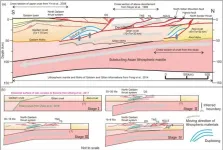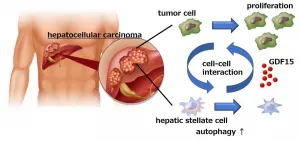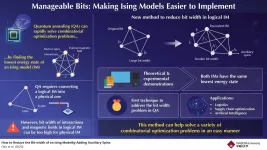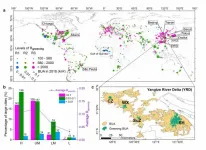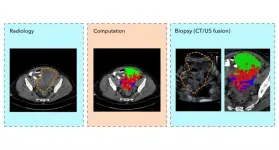Majority of media stories fail to label 'preprint' COVID-19 research -- study
Researchers analyzed more than 500 mentions in over 450 stories from digital news outlets covering preprint COVID-19 research
2021-01-06
(Press-News.org) A new SFU-led study finds that less than half of media stories in early 2020 featuring COVID-19 "preprint" research--research that has not yet been peer-reviewed--accurately framed the studies as being preprints or unverified research.
SFU PhD student Alice Fleerackers, a researcher in the Scholarly Communications Lab, and publishing program professor Juan Pablo Alperin collaborated with an international team of researchers to analyze more than 500 mentions in over 450 stories from digital news outlets covering preprint COVID-19 research. The study was published this week in Health Communication.
Their analysis is based on 100 COVID-19 preprints posted on top-ranked preprint servers medRxiv and bioRxiv from January 1 to April 30, 2020.
"We found that it wasn't just newer, less 'traditional' media outlets, like Medium or Yahoo! News that did not accurately identify the research as preprint or preliminary," Fleerackers says. "Even established publications like The New York Times and The Guardian did not consistently describe the preprints they covered as unreviewed."
The media's coverage of COVID-19 preprints may in part be a reflection of larger pressures facing the scientific community. "The urgency of the pandemic required researchers and journalists to sacrifice the assurances of peer review for more rapid publication," Alperin explains. "Just as researchers are adjusting to the new way of rapidly communicating among each other, so too are journalists figuring out how that greater uncertainty needs to be conveyed to the public."
Fleerackers notes that coverage of preprint research can be helpful to the public. For example, sharing findings about promising prevention strategies as early as possible can save lives. But it can also undermine the public's trust in the media if a preprint is mischaracterized as widely accepted science but the findings are later discredited.
"We saw this with a couple of high profile preprints published at the beginning of the pandemic, for example, which linked tobacco to COVID-19 prevention," she explains. "These studies were highly flawed, but they got a ton of media coverage--sparking unnecessary panic and even encouraging some people to pick up smoking."
The early months of the pandemic offered few examples of best practices to turn to and the science continued to evolve, rapidly changing what was known about the virus and how the public could best protect themselves from becoming infected. Fleerackers adds that reporters covering coronavirus often had little or no expertise in health and science.
"Journalists have not had an easy year. All things considered, I'm impressed with what they've been able to accomplish despite the odds," she says. "And overall, audiences seem to be responding well. Many countries saw a boost in news consumption during the early stages of the pandemic, and trust in journalism has been high."
INFORMATION:
ELSE PRESS RELEASES FROM THIS DATE:
2021-01-06
As the largest orogenic plateau on earth, the Qinghai-Tibet Plateau was caused by a complex crustal deformation process during the continuous collision and compression process between the Indian and Eurasian continents starting at least 60-50 Ma ago. The formation of the Qinghai-Tibet Plateau records the collision of the two continents and the deformation process and mechanism within the continents. Therefore, Qinghai-Tibet Plateau is considered as a natural ideal laboratory for the study of continent-continent collision and dynamics. At present, the continuous collision between Eurasia and Indian continents is still ongoing, ...
2021-01-06
Osaka, Japan - Hepatocellular carcinoma (HCC), frequently seen in patients with liver cirrhosis caused by alcohol abuse or chronic viral hepatitis, is the most common form of liver cancer worldwide. As such, it is the third-most common cause of cancer-related death and has a notoriously poor prognosis. At present, surgery is the most effective treatment for HCC, but is only successful in the 10%-20% of cases where cancer cells have not spread beyond the liver.
Given the lack of treatment options for HCC, a group of researchers led by Osaka University decided to focus on specific cells and processes that occur in the area around liver tumors in the hope of finding a novel target for drug development.
The results of their study were published in a recent issue of Gastroenterology.
"Hepatic ...
2021-01-06
Given a list of cities and the distances between each pair of cities, how do you determine the shortest route that visits each city exactly once and returns to the starting location? This famous problem is called the "traveling salesman problem" and is an example of a combinatorial optimization problem. Solving these problems using conventional computers can be very time-consuming, and special devices called "quantum annealers" have been created for this purpose.
Quantum annealers are designed to find the lowest energy state (or "ground state") of what's known as an "Ising model." Such models are abstract representations of a quantum mechanical system involving interacting spins that are also influenced by external magnetic ...
2021-01-06
The world has experienced dramatic urbanization in recent decades. According to the latest report from the United Nations (UN), the global population in 2018 was 7.6 billion and the urban population was 4.2 billion. By 2050, the global population is expected to soar to 9.7 billion, with 68% of the population living in urban areas. (Note 1)
In the first-ever study on the characteristics of urbanization in large cities around the world, researchers at the Department of Civil Engineering of the University of Hong Kong (HKU) analyzed cities' urban built-up areas (BUAs) expansion, population growth and greening BUA changes, and revealed a hugely uneven ...
2021-01-06
A new advanced computing technique using routine medical scans to enable doctors to take fewer, more accurate tumour biopsies, has been developed by cancer researchers at the University of Cambridge.
This is an important step towards precision tissue sampling for cancer patients to help select the best treatment. In future the technique could even replace clinical biopsies with 'virtual biopsies', sparing patients invasive procedures.
The research published in European Radiology shows that combining computed tomography (CT) scans with ultrasound images creates a visual guide for doctors to ensure they sample the full complexity of ...
2021-01-06
In the future, the Antarctic could become a greener place and be colonised by new species. At the same time, some species will likely disappear. 25 researchers recently presented these and many other findings in a major international project, in which they analysed hundreds of articles on the Antarctic published in the past ten years. By doing so, the team have provided an exceptionally comprehensive assessment of the status quo and future of Antarctica and the Southern Ocean that surrounds it.
Never before have researchers arrived at so many new findings on the biological and biochemical processes at work in the Antarctic than in the past ten years. Now 25 experts, led by the Alfred Wegener Institute Helmholtz Centre for Polar and Marine Research (AWI), have analysed and compiled these ...
2021-01-06
Smoking is associated with an increased risk of COVID-19 symptoms and smokers are more likely to attend hospital than non-smokers, a study has found.
The study published today in Thorax, by researchers from King's College London, investigates the association between smoking and the severity of the COVID-19.
Researchers analysed data from the ZOE COVID Symptom Study App. Of the participants of the app, 11% were smokers. This is a lower proportion than the overall UK population of 14.7%, however, it reflects the demographics of the self-selected sample of the ZOE COVID Symptom Study.
While more than a third of users reported not feeling physically well during the period of study (24th March and April 2020), current smokers were 14% more likely to develop the classic triad of ...
2021-01-06
DALLAS, Jan. 6, 2021 -- Statins, common cholesterol-lowering medications, may protect women's hearts from damage caused during chemotherapy for early-stage breast cancer, according to new research published today in the Journal of the American Heart Association, an open access journal of the American Heart Association.
"Two types of cancer medications, anthracyclines and trastuzumab, are effective treatments for many women with breast cancer, however, the risk of heart muscle damage has limited their use, particularly in women who are at higher risk for heart problems because of their age or other medical issues," said Husam Abdel-Qadir, M.D., Ph.D., lead author of the study, assistant professor of medicine at the University of Toronto's ...
2021-01-06
Toronto - New research from UHN's Peter Munk Cardiac Centre (PMCC) shows statins, commonly prescribed to lower cholesterol and reduce the risk of heart disease and stroke, may also protect the heart from damaging side-effects of early breast cancer treatment.
Published Jan. 6, 2021 in the Journal of the American Heart Association, an observational study found women already taking statins and treated with either anthracyclines or trastuzumab were half as likely to be hospitalized or visit an Emergency Department for heart failure within five years after chemotherapy.
"Our job is to protect the heart and ensure it has the greatest fighting chance to get through chemotherapy," says Dr. Husam Abdel-Qadir, lead author of the paper and a cardiologist at the PMCC and Women's College ...
2021-01-06
Separating infants and their mothers after a Caesarean section delivery is common. A new study published in END ...
LAST 30 PRESS RELEASES:
[Press-News.org] Majority of media stories fail to label 'preprint' COVID-19 research -- study
Researchers analyzed more than 500 mentions in over 450 stories from digital news outlets covering preprint COVID-19 research
